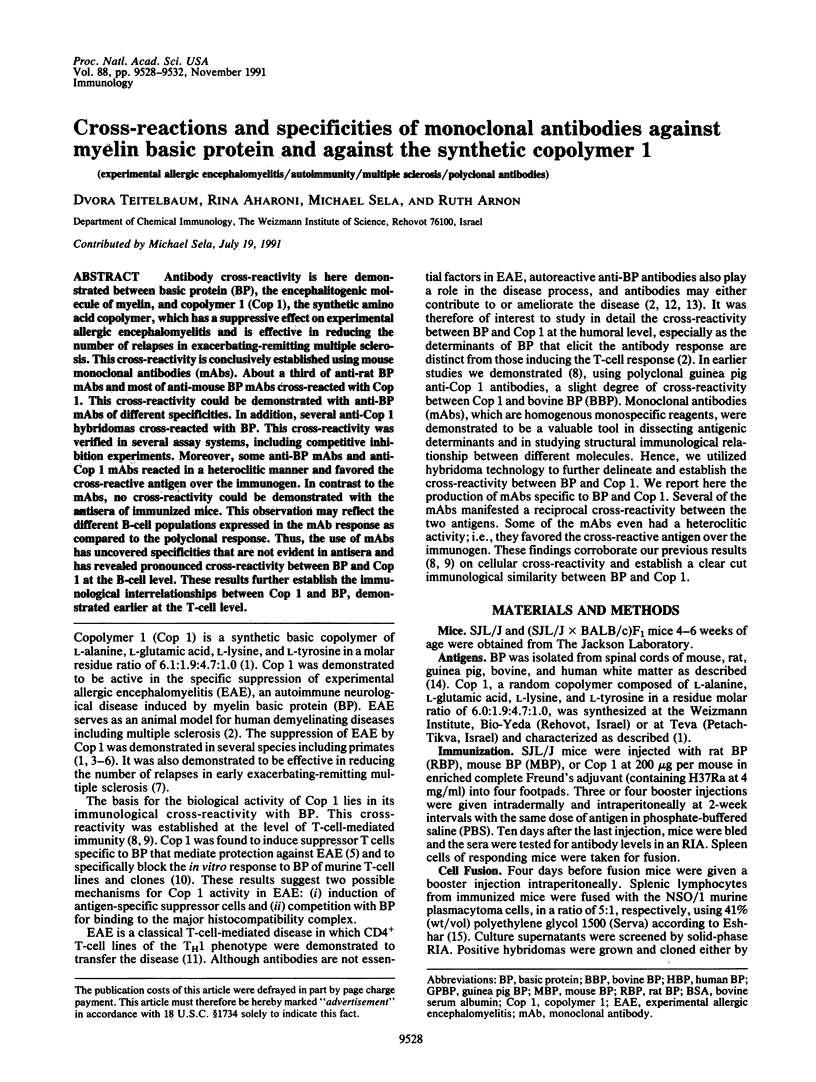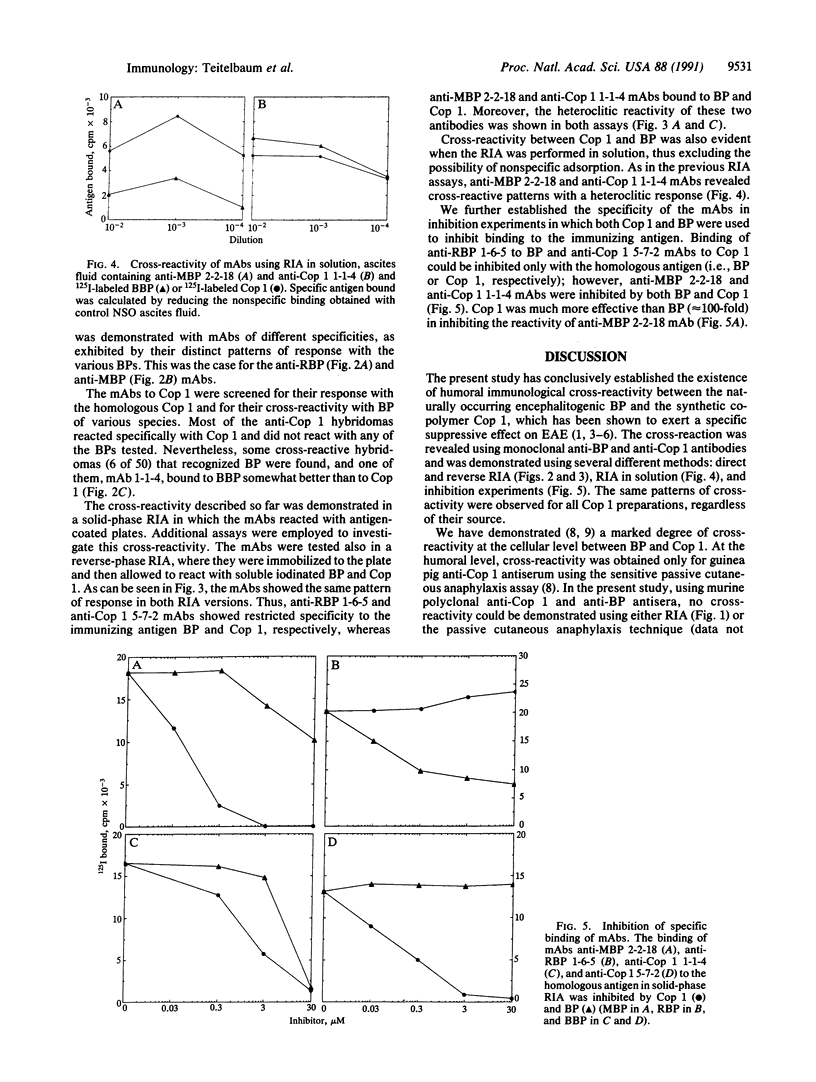Abstract
Antibody cross-reactivity is here demonstrated between basic protein (BP), the encephalitogenic molecule of myelin, and copolymer 1 (Cop 1), the synthetic amino acid copolymer, which has a suppressive effect on experimental allergic encephalomyelitis and is effective in reducing the number of relapses in exacerbating-remitting multiple sclerosis. This cross-reactivity is conclusively established using mouse monoclonal antibodies (mAbs). About a third of anti-rat BP mAbs and most of anti-mouse BP mAbs cross-reacted with Cop 1. This cross-reactivity could be demonstrated with anti-BP mAbs of different specificities. In addition, several anti-Cop 1 hybridomas cross-reacted with BP. This cross-reactivity was verified in several assay systems, including competitive inhibition experiments. Moreover, some anti-BP mAbs and anti-Cop 1 mAbs reacted in a heteroclitic manner and favored the cross-reactive antigen over the immunogen. In contrast to the mAbs, no cross-reactivity could be demonstrated with the antisera of immunized mice. This observation may reflect the different B-cell populations expressed in the mAb response as compared to the polyclonal response. Thus, the use of mAbs has uncovered specificities that are not evident in antisera and has revealed pronounced cross-reactivity between BP and Cop 1 at the B-cell level. These results further establish the immunological interrelationships between Cop 1 and BP, demonstrated earlier at the T-cell level.
Full text
PDF




Selected References
These references are in PubMed. This may not be the complete list of references from this article.
- Allegretta M., Nicklas J. A., Sriram S., Albertini R. J. T cells responsive to myelin basic protein in patients with multiple sclerosis. Science. 1990 Feb 9;247(4943):718–721. doi: 10.1126/science.1689076. [DOI] [PubMed] [Google Scholar]
- Andersson J., Melchers F. The antibody repertoire of hybrid cell lines obtained by fusion of X63-AG8 myeloma cells with mitogen-activated B-cell blasts. Curr Top Microbiol Immunol. 1978;81:130–139. doi: 10.1007/978-3-642-67448-8_19. [DOI] [PubMed] [Google Scholar]
- Bornstein M. B., Miller A., Slagle S., Weitzman M., Crystal H., Drexler E., Keilson M., Merriam A., Wassertheil-Smoller S., Spada V. A pilot trial of Cop 1 in exacerbating-remitting multiple sclerosis. N Engl J Med. 1987 Aug 13;317(7):408–414. doi: 10.1056/NEJM198708133170703. [DOI] [PubMed] [Google Scholar]
- Datta S. K., Stollar B. D., Schwartz R. S. Normal mice express idiotypes related to autoantibody idiotypes of lupus mice. Proc Natl Acad Sci U S A. 1983 May;80(9):2723–2727. doi: 10.1073/pnas.80.9.2723. [DOI] [PMC free article] [PubMed] [Google Scholar]
- Day E. D., Potter N. T. Monoclonal and polyclonal antibodies to myelin basic protein determinants. J Neuroimmunol. 1986 Feb;10(4):289–312. doi: 10.1016/S0165-5728(86)90014-7. [DOI] [PubMed] [Google Scholar]
- GREENWOOD F. C., HUNTER W. M., GLOVER J. S. THE PREPARATION OF I-131-LABELLED HUMAN GROWTH HORMONE OF HIGH SPECIFIC RADIOACTIVITY. Biochem J. 1963 Oct;89:114–123. doi: 10.1042/bj0890114. [DOI] [PMC free article] [PubMed] [Google Scholar]
- Gausas J., Paterson P. Y., Day E. D., Dal Canto M. C. Intact B-cell activity is essential for complete expression of experimental allergic encephalomyelitis in Lewis rats. Cell Immunol. 1982 Sep 15;72(2):360–366. doi: 10.1016/0008-8749(82)90484-1. [DOI] [PubMed] [Google Scholar]
- Gow A., Smith R. The thermodynamically stable state of myelin basic protein in aqueous solution is a flexible coil. Biochem J. 1989 Jan 15;257(2):535–540. doi: 10.1042/bj2570535. [DOI] [PMC free article] [PubMed] [Google Scholar]
- Hirshfeld H., Teitelbaum D., Arnon R., Sela M. Basic encephalitogenic protein: A simplified purification on sulphoethyl-sephadex. FEBS Lett. 1970 May 1;7(4):317–320. doi: 10.1016/0014-5793(70)80193-4. [DOI] [PubMed] [Google Scholar]
- Lando Z., Teitelbaum D., Arnon R. Effect of cyclophosphamide on suppressor cell activity in mice unresponsive to EAE. J Immunol. 1979 Nov;123(5):2156–2160. [PubMed] [Google Scholar]
- MacPhee I. A., Day M. J., Mason D. W. The role of serum factors in the suppression of experimental allergic encephalomyelitis: evidence for immunoregulation by antibody to the encephalitogenic peptide. Immunology. 1990 Aug;70(4):527–534. [PMC free article] [PubMed] [Google Scholar]
- Martin R., Howell M. D., Jaraquemada D., Flerlage M., Richert J., Brostoff S., Long E. O., McFarlin D. E., McFarland H. F. A myelin basic protein peptide is recognized by cytotoxic T cells in the context of four HLA-DR types associated with multiple sclerosis. J Exp Med. 1991 Jan 1;173(1):19–24. doi: 10.1084/jem.173.1.19. [DOI] [PMC free article] [PubMed] [Google Scholar]
- Ota K., Matsui M., Milford E. L., Mackin G. A., Weiner H. L., Hafler D. A. T-cell recognition of an immunodominant myelin basic protein epitope in multiple sclerosis. Nature. 1990 Jul 12;346(6280):183–187. doi: 10.1038/346183a0. [DOI] [PubMed] [Google Scholar]
- Paterson P. Y., Day E. D. Current perspectives of neuroimmunologic disease: multiple sclerosis and experimental allergic encephalomyelitis (1,2). Clin Immunol Rev. 1981;1(4):581–697. [PubMed] [Google Scholar]
- Sigal N. H. Regulation of azophenylarsonate-specific repertoire expression. 1. Frequency of cross-reactive idiotype-positive B cells in A/J and BALB/c mice. J Exp Med. 1982 Nov 1;156(5):1352–1365. doi: 10.1084/jem.156.5.1352. [DOI] [PMC free article] [PubMed] [Google Scholar]
- Teitelbaum D., Aharoni R., Arnon R., Sela M. Specific inhibition of the T-cell response to myelin basic protein by the synthetic copolymer Cop 1. Proc Natl Acad Sci U S A. 1988 Dec;85(24):9724–9728. doi: 10.1073/pnas.85.24.9724. [DOI] [PMC free article] [PubMed] [Google Scholar]
- Teitelbaum D., Meshorer A., Hirshfeld T., Arnon R., Sela M. Suppression of experimental allergic encephalomyelitis by a synthetic polypeptide. Eur J Immunol. 1971 Aug;1(4):242–248. doi: 10.1002/eji.1830010406. [DOI] [PubMed] [Google Scholar]
- Teitelbaum D., Webb C., Bree M., Meshorer A., Arnon R., Sela M. Suppression of experimental allergic encephalomyelitis in Rhesus monkeys by a synthetic basic copolymer. Clin Immunol Immunopathol. 1974 Nov;3(2):256–262. doi: 10.1016/0090-1229(74)90012-9. [DOI] [PubMed] [Google Scholar]
- Teitelbaum D., Webb C., Meshorer A., Arnon R., Sela M. Suppression by several synthetic polypeptides of experimental allergic encephalomyelitis induced in guinea pigs and rabbits with bovine and human basic encephalitogen. Eur J Immunol. 1973 May;3(5):273–279. doi: 10.1002/eji.1830030505. [DOI] [PubMed] [Google Scholar]
- Webb C., Teitelbaum D., Arnon R., Sela M. In vivo and in vitro immunological cross-reactions between basic encephalitogen and synthetic basic polypeptides capable of suppressing experimental allergic encephalomyelitis. Eur J Immunol. 1973 May;3(5):279–286. doi: 10.1002/eji.1830030506. [DOI] [PubMed] [Google Scholar]
- Webb C., Teitelbaum D., Herz A., Arnon R., Sela M. Molecular requirements involved in suppression of EAE by synthetic basic copolymers of amino acids. Immunochemistry. 1976 Apr;13(4):333–337. doi: 10.1016/0019-2791(76)90344-x. [DOI] [PubMed] [Google Scholar]
- Zamvil S. S., Steinman L. The T lymphocyte in experimental allergic encephalomyelitis. Annu Rev Immunol. 1990;8:579–621. doi: 10.1146/annurev.iy.08.040190.003051. [DOI] [PubMed] [Google Scholar]


